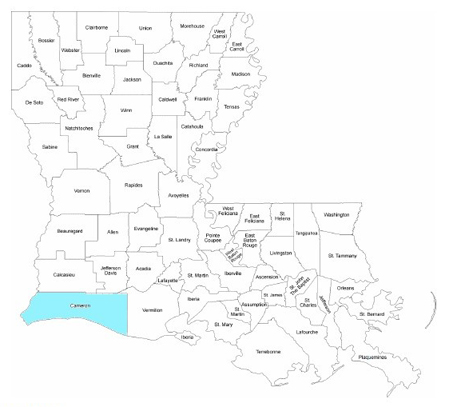




One adult (2009-35) on 2-11 May 2009, Cameron: Grand Chenier, 5.3 mi. E of Hwy. 82 bridge at the Mermentau River; Phillip A. Wallace
(ph) ,
Devin Bosler
(ph) ,
Paul E. Conover ,
Jay V. Huner ,
John P. Sevenair
(ph),
and Rosemary Seidler (ph). First reported on 1 May by Butch Conner fide Cyndi Sellers. Bird possibly present to 14 May, but no documentation submitted. This record involves the well known American Flamingo “HDNT,” originally banded as a chick during summer 2005 at Ria Lagartos Biosphere Reserve on Mexico’s Yucatan Peninsula and seen intermittently on the gulf coast (mainly Texas) since October 2005. During this visit, HDNT was still accompanied by an escapee Greater Flamingo (P. roseus) “492,” as was the case during their first Louisiana visit in September-October 2007 (Dittmann and Cardiff 2010; J. La. Ornith 8:133-134: http://losbird.org/jlo_v8.pdf).

Photo by John Sevenair (American Flamingo on left)
One adult (2011-043) from 21 April – 31 May 2011,
Cameron: Grand Chenier;
Carrie Salyers
(ph) and
Brac Salyers,
James Beck
(ph),
Paul E. Conover
(ph),
Justin Bosler (ph),
Kevin Leigh
(photos only),
J. V. Huner, and Tom Finnie
(photos only). This is the famous “HDNT” (previously LBRC
2007-63, 2009-35) returning for the third visit.

Photo by Carrie Salyers
One adult and one juvenile (2011-111) on 3, 12, and 19 October 2011, Plaquemines: Pass A Loutre WMA, ca 2.75 mi. SE Pilottown. This was a well-documented record supported by photographs of adult and juvenile – both individuals were unbanded. The record went to Discussion Round. Identification seemed straightforward, but Members were divided regarding provenance, with major differences of opinion on interpreting general patterns of vagrancy in flamingoes, records of individuals of known provenance, and movements of wild and feral birds in association with tropical weather systems. Only one known wild individual (banded “HDNT,” originating from the Yucatan population photo right) has occurred in Louisiana (see 10th, 13th, and 15th Reports of the LBRC). A couple of other banded Yucatan birds have turned up in Cuba and Florida. However, provenance of free-flying Florida birds is clouded by known feral populations and the propensity of known feral/escaped flamingoes (of various species) to turn up in “good flamingo habitat,” specifically note HDNT’s companion (see photo previous page) was a known escape. With few confirmed records of known wild flamingoes, it is difficult to assess wild origin of “vagrants.” Another aspect of this record was that it involved an adult with a juvenile (not just an immature), and some Members believed that this was more indicative of feral origin insomuch as one could argue that adults would be much less likely candidates for long distance vagrancy. Ultimately, three Members believed“questionable origin” was the most prudent course, and, although other Members accepted as “origin hypothetical,” this vote resulted in the record becoming unacceptable based on questionable origin.
One (2019-040) on 28 May 2019, St. John the Baptist: I-55 along the Maurepas Swamp WMA. All Members believed that Roseate Spoonbill was not eliminated.
One adult (2019-040) on 11 October 2019, Madison: Eagle Lake, N32.5295o, W91.0501o (photos). There was no doubt as to the identification and, apparently, the bird was present the previous day and was reported by a photographer to the submitting observer. Although one Member speculated that perhaps it was the same bird observed in TN/MO in July 2019, or was the St. Marks NWR bird which apparently showed up shortly after Hurricane Michael, the majority of Members were not convinced that the occurrence was correlated with any tropical weather event or that those other records involved wild individuals. The lower legs were not visible so it could not be determined whether there were bands on the lower legs. Ultimately, most Members believed that the record was best left as “Origin Questionable.”